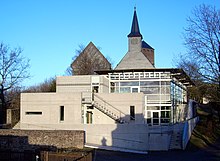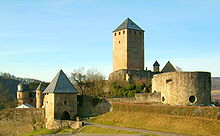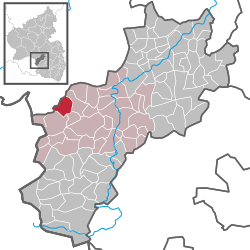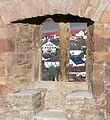Thallichtenberg
Thallichtenberg | |
|---|---|
| Coordinates: 49°33′28″N 7°21′05″E / 49.55778°N 7.35139°E | |
| Country | Germany |
| State | Rhineland-Palatinate |
| District | Kusel |
| Municipal assoc. | Kusel-Altenglan |
| Government | |
| • Mayor (2019–24) | Annika Süssel[1] |
| Area | |
| • Total | 5.72 km2 (2.21 sq mi) |
| Elevation | 287 m (942 ft) |
| Population (2022-12-31)[2] | |
| • Total | 546 |
| • Density | 95/km2 (250/sq mi) |
| Time zone | UTC+01:00 (CET) |
| • Summer (DST) | UTC+02:00 (CEST) |
| Postal codes | 66871 |
| Dialling codes | 06381 |
| Vehicle registration | KUS |
Thallichtenberg is an
Geography
Location
The municipality lies in the Kusel Musikantenland in the Western Palatinate. The municipal area measures 571 ha, of which 163 ha is wooded. Thallichtenberg lies roughly 300 m above sea level northwest of Lichtenberg Castle (382 m above sea level) in a broad hollow between the Burgberg (“Castle Mountain”) and the so-called Prussian Mountains (Preußische Berge), which here, on the heights of the Wolfsbösch, reach 572 m above sea level. Down in the dale, the village site abuts the Pfeffelbach (brook), which here turns from its south-to-north direction of flow towards the east, forming a narrow gorge between the Burgberg and the Niederberg within Ruthweiler’s limits. Several small brooks (Löschbach, Bisterbach, Kurzer Bach) flow into the Pfeffelbach within Thallichtenberg.[3]
Neighbouring municipalities
Thallichtenberg borders in the north on the town of Baumholder, in the northeast and east on the municipality of Körborn, in the southeast on the municipality of Ruthweiler, in the south on the municipality of Pfeffelbach, in the west on the municipality of Berschweiler bei Baumholder and in the northwest on the municipality of Mettweiler.
Constituent communities
Also belonging to Thallichtenberg are the outlying homesteads of Burg Lichtenberg and Berghof.[4]
Municipality’s layout
The village of Thallichtenberg shows the attributes of a typical clump village, with streets spreading out in a starlike shape from the midpoint into the dales through which the smaller brooks flow and over the heights in between. The road leading to the castle branches off from the village thoroughfare at the village's southern end. About halfway up, on both sides of the road, lies the graveyard. The former Jewish graveyard, which now stands under monumental protection, can be found in the municipality's northwest near the sporting ground. New building areas have been laid out mainly in the north. On the heights far out of the village, below the Wolfsbösch and near the Breitsesterhof, which belongs to Baumholder, lies the Berghof, one of Thallichtenberg's outlying homesteads.

Institutions of national importance are housed within the old castle complex, the Musikantenlandmuseum, for instance, which deals with the history of travelling musicians from this region, and also the Geoskop (museum of primitive times), a branch location of the
History
Antiquity
In the late
Middle Ages
The village of Thallichtenberg might have been founded only once the castle was built in the early 13th century. Thallichtenberg, and also a number of villages that have since vanished, only appear in documents dating from after the castle's completion. It would therefore seem that a number of places sprang up in the area around Lichtenberg Castle, of which Thallichtenberg is the only one that still exists. The village of Ruthweiler at the foot of the castle, though, was likely already standing at the time when work on the castle began. At the first documentary mention of Lichtenberg as Castrum Lichtenberg in 1214, only Lichtenberg Castle is mentioned, and no village named Lichtenberg. When the
Modern times
From Zweibrücken times it is clear that only the part of Thallichtenberg that lay on the brook's left bank was counted as one of the villages within the
Recent times
In 1799, there was a great fire at Lichtenberg Castle that burnt most of the buildings, after which – as before the blaze – the castle was subject to plundering. Thallichtenberg and the castle belonged at the time of French
Population development
Until the
The following table shows population development over the centuries for Thallichtenberg. Separate figures are shown for “Thal” (Thallichtenberg) and “Burg” (castle). Since 1960, however, castle dwellers have not been counted separately, and figures for the municipality as a whole are given under “Thal”; there have been about 10 dwellers at the castle (included in the “Thal” total) in recent times:[12]
| Year | 1609 | 1648 | 1819 | 1843 | 1861 | 1895 | 1926 | 1960 | 2000 | 2007 | 2008 |
| Thal | 111 | – | 334 | 402 | 469 | 532 | 683 | 632 | 681 | 662 | 621 |
| Burg | 61 | ? | ? | 60 | 8 | 83 | 78 | ~10 | ~10 | ~10 | ~10 |
Municipality’s name
The village's name, Thallichtenberg, has its origin in the castle's name, Lichtenberg. This fortification was held to be a castle on a light (in colour, that is) mountain, or Burg auf dem lichten Berg in
Vanished villages
Within what are today Thallichtenberg's municipal limits once lay a whole series of villages, most of which vanished even before the Thirty Years' War. In 1371, a village named Berweiler (Berwilre) was mentioned, which was described in 1588 by Johannes Hoffmann as “ehemalige Dorfstadt” (“former village-town”); it might have lain west of Thallichtenberg. To Thallichtenberg's north lay Bistert, likely in the area of the road that today leads to
Religion
Throughout
Politics
Municipal council
The council is made up of 12 council members, who were elected by
Mayor
Thallichtenberg's mayor is Annika Süssel.[1]
Coat of arms
The German blazon reads: In geteiltem Schild oben in Silber ein wachsender, rotbewehrter und -bezungter, blauer Löwe, unten von Grün und Silber dreifach geteilt, auf den grünen Balken fünf silberne Kugeln 3:2.[17]
The municipality's arms might in English heraldic language be described thus: Per fess argent a demilion azure armed and langued gules and barry of four vert and argent, the bars charged with five roundels of the first, three and two.
The
The arms have been borne since 1963 when they were approved by the Rhineland-Palatinate Ministry of the Interior.[18]
Culture and sightseeing
Buildings


The following are listed buildings or sites in Rhineland-Palatinate’s Directory of Cultural Monuments:[19]
- Jewish graveyard (monumental zone) – older part laid out in 1725, newer part in 1845; 140 gravestones, beginning from 1747
- Lichtenberg Castle (monumental zone) – built by Count Gerlach III of Veldenz, first mentioned in 1214, burnt down in 1799; girding walls, gateway arch and wall remnants of the Lower Castle begun about 1200, keep with inner ringwall of the Upper Castle begun about 1270 with 16th-century battery tower and two palatial buildings, earlier half of the 14th century and earlier half of the 15th century, Evangelical church and state scrivener’s office from the 18th century; Palatinate’s biggest castle complex
- Evangelical church, Burgstraße 18 – rectangular plastered building with ridge turret, 1755-1758, ridge turret’s pointed spire 1874
Regular events
The municipality celebrates a May Day Festival (Maifest) on 30 April and 1 May, while Kirchweih, the church consecration festival, is held on the second weekend in August.[20]
Clubs
There are several clubs in Thallichtenberg, currently an
Economy and infrastructure
Economic structure
At the time of the feudal lordship, the villagers were to a great extent dependent on the castle, which was for them an important basis on which livelihoods were earned. During the 19th and early 20th centuries, the castle served the cutlers and nailers as a dwelling place. Even today, it is regarded as an important income earner, although now its use as such comes from tourism and the many thousands of visitors that that draws to the castle each year. Apart from that, agriculture was also held to be the most important source of income in earlier times. It must be borne in mind, too, that in farming households, especially in winter, wool was spun, and many looms were to be found in houses. Farmers drove their horsecarts to town, particularly to Oberstein, and to market in Sankt Wendel to sell their wares. Within Thallichtenberg's limits were no collieries, but there may have been some nearby. Tourism now offers some opportunities. Thallichtenberg is otherwise a commuter community.[22]
Education
Education history
In 1577, for the first time, a schoolmaster's name appeared in the historical record. He taught at the Lichtenberg Castle
Schooling today
Since Thallichtenberg's transfer to the Kusel district in 1969,
Transport
To the south runs the
Famous people
Sons and daughters of the town
-
View of the village
-
View through a window
References
- ^ a b Direktwahlen 2019, Landkreis Kusel, Landeswahlleiter Rheinland-Pfalz, accessed 3 August 2021.
- Statistisches Landesamt Rheinland-Pfalz. 2023.
- ^ Thallichtenberg’s location
- ^ Thallichtenberg’s constituent communities
- ^ Thallichtenberg’s layout
- ^ Heimatbuch des Landkreises St. Wendel, XVIII. Ausgabe, 1979/1980, p110[permanent dead link]
- ^ Thallichtenberg’s ancient history
- ^ Thallichtenberg’s mediaeval history
- ^ Thallichtenberg’s modern history
- ^ Merger
- ^ Thallichtenberg’s recent history
- ^ Thallichtenberg’s population development
- ^ Thallichtenberg’s name
- ^ Vanished villages in Thallichtenberg
- ^ Religion in Thallichtenberg
- ^ Kommunalwahl Rheinland-Pfalz 2009, Gemeinderat
- ^ Description of Thallichtenberg’s arms Archived 2007-09-27 at the Wayback Machine
- ^ Explanation of Thallichtenberg’s arms
- ^ Directory of Cultural Monuments in Kusel district
- ^ Regular events in Thallichtenberg
- ^ Clubs in Thallichtenberg
- ^ Thallichtenberg’s economic structure
- ^ Education in Thallichtenberg
- ^ Transport in Thallichtenberg
External links
- Thallichtenberg in the collective municipality’s webpages (in German)
- Thallichtenberg at Musikantenland (in German)
- Urweltmuseum homepage (in German)








